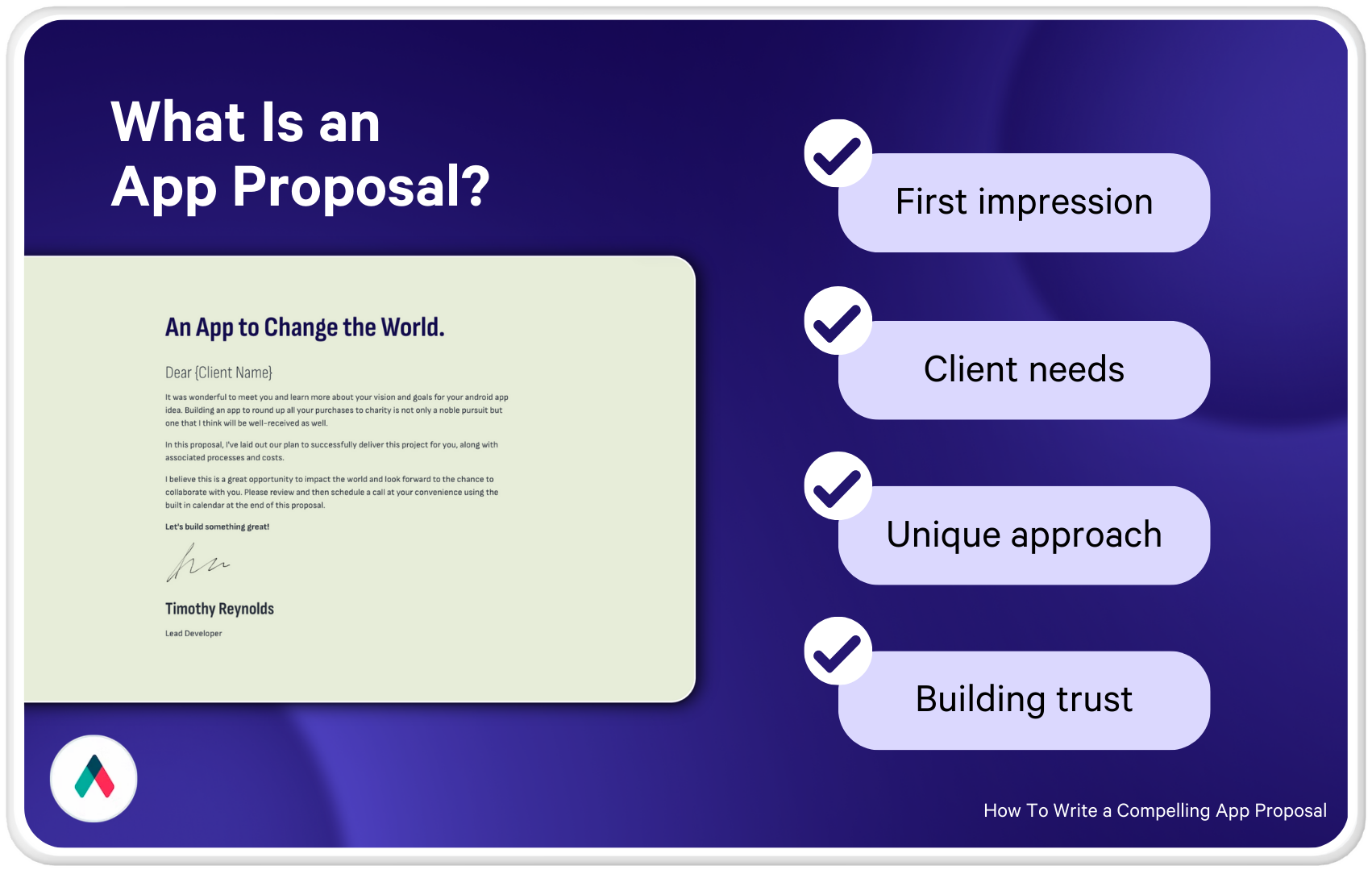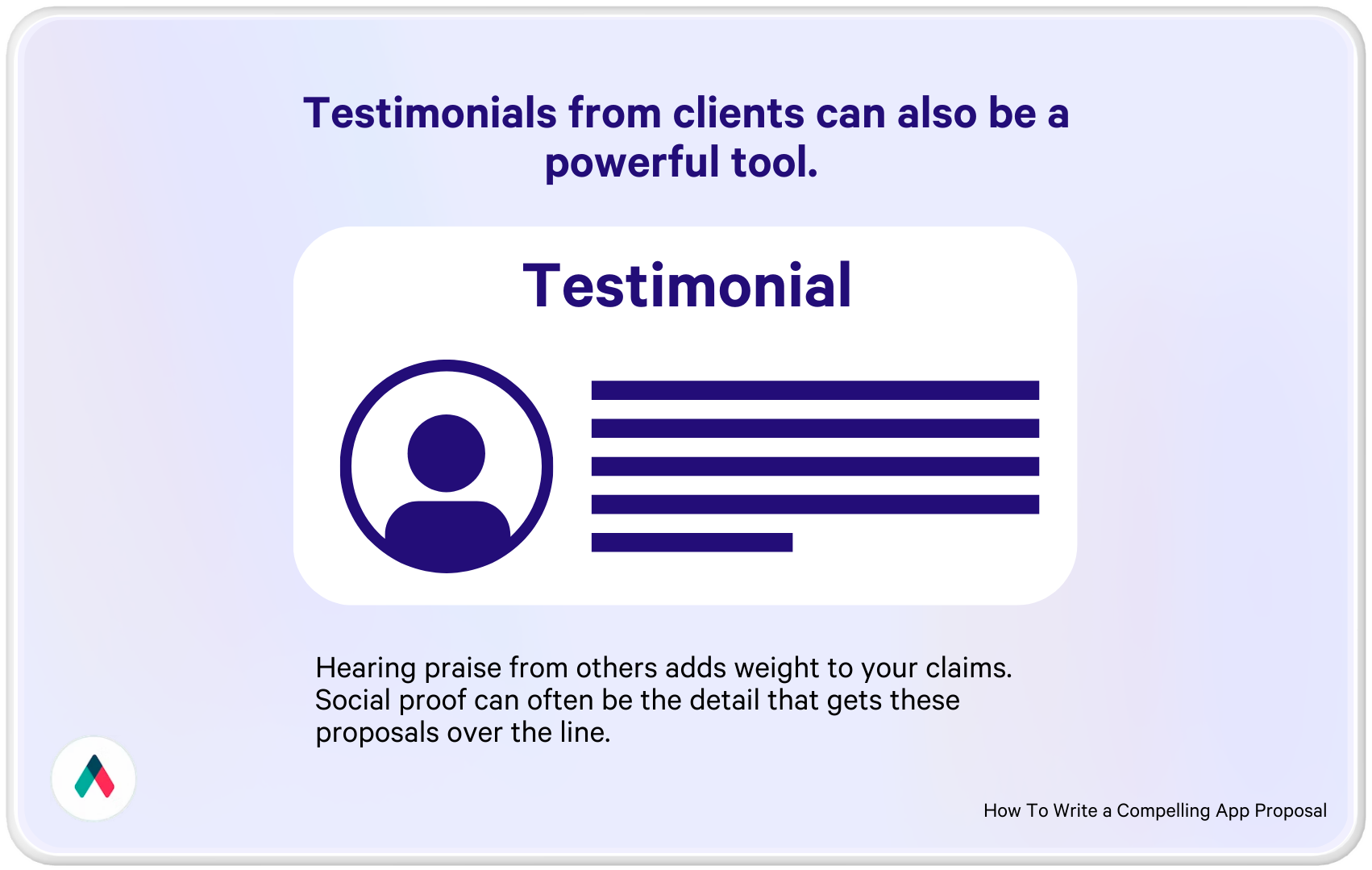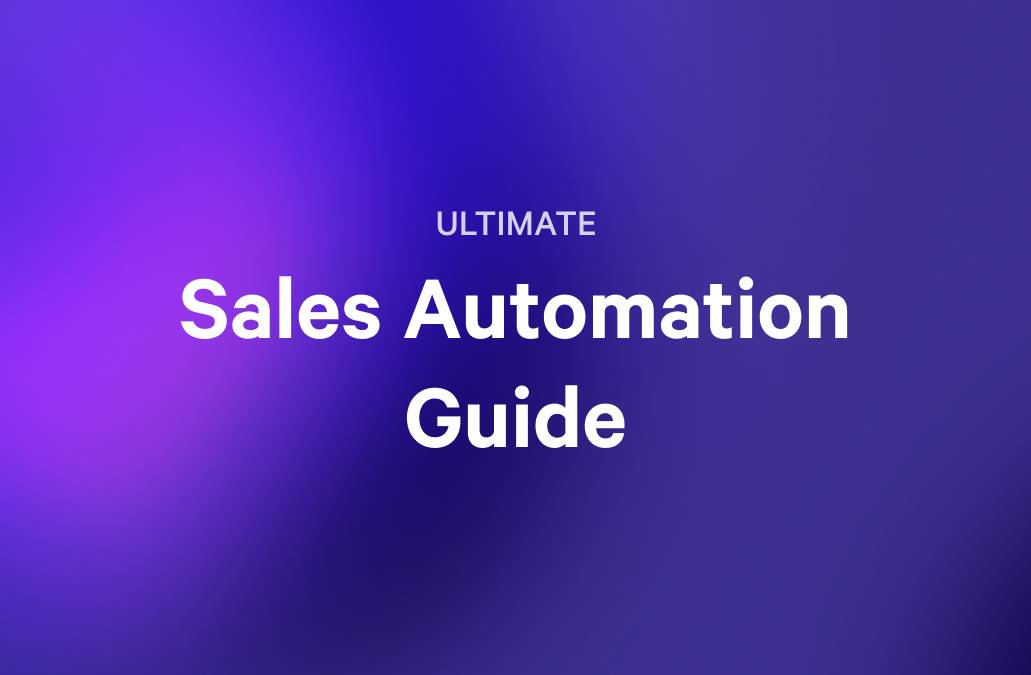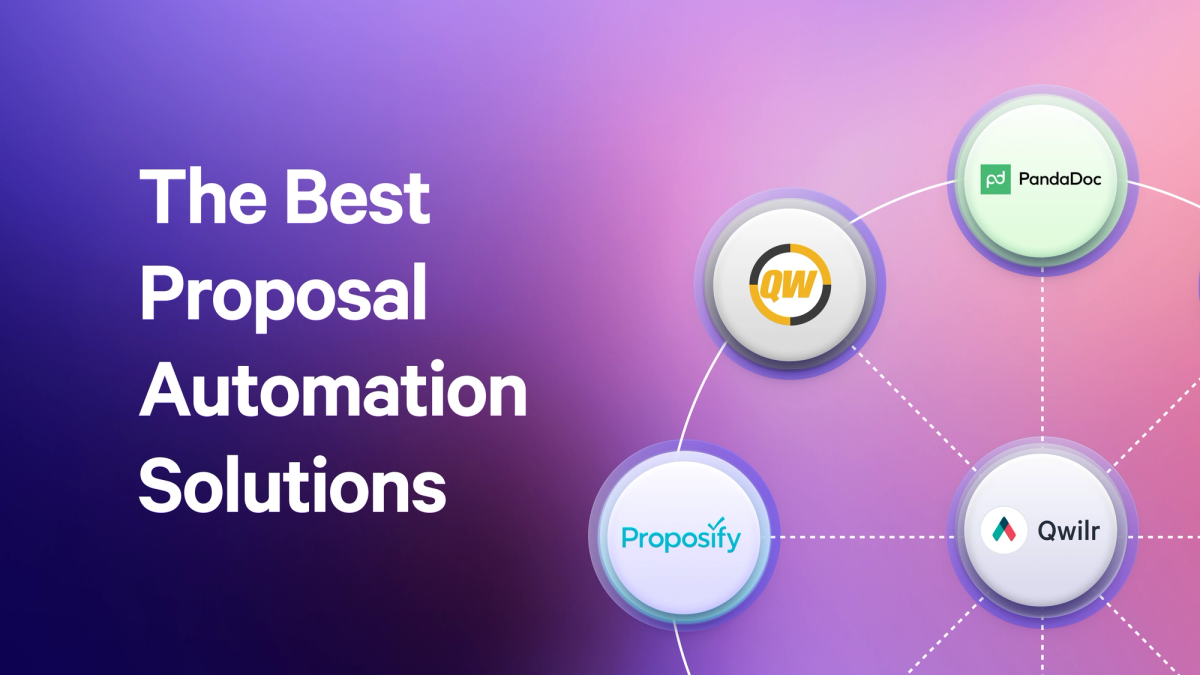You have the skills and the vision to develop an outstanding app, but how do you convey this brilliance in a proposal? This can actually be a stumbling block for even the most experienced developers- after all, they are two very different skill sets!
This is where we come in.
We know that the magic isn't only in what you can do but also in how you present it. With this guide, we'll help you express your vision and expertise in a way that truly resonates with your clients. You'll learn to understand their needs, present your unique solutions, and come across as confident, competent developer you really are.
TLDR: Create a mobile development app proposal in minutes
What is an app proposal?
An app development proposal is more than just a document: it's your first impression, business plan, and roadmap all rolled into one.
This is where you introduce your ideas, show that you understand the client's needs, and explain your unique approach. The app proposal isn't just about technical know-how but also about communicating effectively, building trust, and proving that you're the right person for the job.

Steps to write an app proposal
Here, we’ll demystify the process, breaking it down into the simple, actionable steps to turn your app idea into a compelling offer.
1. Understand the client's needs
You're not just looking at what they want their app project to do but also why they want it. What problems do they want to solve? How does the app fit into the overall picture of the business? These questions are the key to a customized, tailor-made offer.
Active listening is essential here. When you talk to the client, it's about asking questions, and lots of them. “That’s why you have two ears and one mouth,” my grandmother loved to tell me. (I later found out she stole that from a Greek philosopher…)
Sometimes, you may need to read between the lines or probe a bit further. Do whatever it takes to get the whole picture. Truly comprehending their needs pays dividends when presenting an engaging, personalized proposal.
2. Conduct in-depth research and analysis
Research isn't just about gathering facts but also about understanding the story behind the business. Who are their customers? What challenges are they facing? These are some critical questions that your project proposal should answer. If you know the business inside and out, you can develop an app that feels like a natural extension of the company's brand.
But the research doesn't end there. Keep exploring beyond the basics. Check out how your target audience communicates online and what methods work best for them. Now, broaden your perspective. Look at their competitors and see how your app can stand out and present a unique advantage. This step is about gathering a wealth of information and then distilling it into actionable insights. Understanding the 'what' and the 'why' behind the client's needs.
3. Create a project plan
This is where your app development project goes from a concept to a concrete plan you can share with your client. Start with the big picture: Break the project down into key phases such as discovery, design, development, testing, and launch.
You can also use a mobile app development proposal in this phase, like the template we offer at Qwilr. A template works like a checklist, reminding you to include all the vital things – from the project's duration to the challenges you'll tackle. It also saves you precious time you can spend on the content itself (as opposed to just the layout and adding your brand elements!).
Qwilr’s app development proposal template not only looks the part, but it can be easily customized to fit your branding and incorporate the interactive features that help a proposal come to life. Check out a preview to see for yourself.
4. Outline the budget and pricing
This step is about clearly stating the costs and showing your client exactly where their money goes. You're not just throwing numbers at your client. Instead, you're guiding them through the budget with diligence and accountability.
Break down the direct cost for each part of the project – design, development, testing, and so on. The more detailed you are, the better the client will understand the value they're getting.
It's also about connecting each cost to the value it brings. If you charge for custom graphics, explain how they improve the user experience. Be upfront about all costs, including possible additional costs. This honesty builds trust and shows that you respect their budget.
5. Define the Solution
This part is about more than just listing the app's functions. You need to explain what exactly you want your app to do and how each feature will help you achieve your goals. For instance, if you add a booking system to the app design, explain how it will make life easier for the business and its customers.
Then, go into the technical details. Talk about the platforms the app will run on, the technologies you will use, and why they are perfect for this project. Don't forget to talk about the customer experience. Describe how the app will look and feel to the user. This is where you show your client that you're not just building an app but crafting an experience.
6. Explain the design and user experience strategy
In this section, showcase your expertise around the design and user experience choices you'll make. Creating an app isn't just about technical chops but also about making something easy to use and accessible. This is your chance to impress your client with your design skills and understanding of user needs.
Start by describing the visual design, creating a look that reflects the client's brand and attracts users. Explain why you chose certain fonts or images and how they fit into the look. Then, move on to the user experience (UX). Here, you're focusing on how users navigate and interact with the app. For guidance on preventing issues, see how to stop apps crashing on Android for a smoother user experience.
7. Propose a testing and quality assurance strategy
Your prospective client wants to know that you have a plan to ensure your app works correctly right from the start. Outline your plan for testing and quality assurance right in your proposal. How will you conduct testing? Will you use automated testing tools or have manual testers or a combination of both?
Let your client know that you're not just looking for bugs but assuring that every part of the app is smooth and user-friendly. Talk about the different tests, such as testing small parts of the app (unit testing), making sure all parts work together (integration testing), and testing the app by real users (user acceptance testing).
Quality assurance is crucial. It's not just about making sure the app is bug-free but also meeting the users' needs. Describe how you will gather feedback, make updates, and keep up with the latest tech and user trends.
8. Showcase your expertise and past work
This is where you can present your skills and previous successes and convincingly explain why you're the right developer for the job.
Start by outlining your key skills and expertise, relating them to your client's needs. Do you have a knack for developing visually stunning apps? This is your chance to let the client know.
Then, pull out your portfolio. Select some of your best projects that relate to your client's needs. Provide a brief overview of each project: what it was about, what challenges you faced, and how you overcame them.
Testimonials from clients can also be a powerful tool. Hearing praise from others adds weight to your claims. Social proof can often be the detail that gets these proposals over the line.

An example of an app proposal template
An app development proposal template is like having a secret recipe for success right at your fingertips. To get a firsthand look at what we're talking about, check out Qwilr's comprehensive Mobile App Development Proposal Template.
Let's break down what this template includes:
- Overview (Executive summary): Consider this the opening act of your proposal. It's your chance to set the stage and give your client a sneak peek of what lies ahead. In this section, you present the big idea in a way that isn't only informative but also captivating.
- Application Components: This section houses the technical details and outlines the most essential components to make your app work. The point is to show off your technical knowledge without overwhelming the reader.
- UX and App Flow: User experience has never been more important. Here is where you describe how users will interact with the app. It's not just about buttons and screens; it's about the journey. You describe how each element contributes to a seamless user experience.
- Timeline: Every client loves to know 'When?'. This section answers all of those burning questions, outlining the project's timeline. It's a clear roadmap of milestones and deadlines, giving your client a sense of security about the project's progression.
- About and Portfolio: This is where you shine a spotlight on yourself. Tell your story, your achievements, and why you are the right choice for this project. Your portfolio proves your skills and backs up your claims with solid evidence.
- Project Investment: This part lays out the financial aspects of the project. It's about being transparent with costs and ensuring there are no surprises down the line.
- CTA and Next Steps: Finally, you want to guide your client on what they should do next. This is your call to action – an invitation to a meeting, a request to get in touch, or steps to get the project moving.
Writing your best app proposals
At Qwilr, we know how important it is to create engaging proposals; melding the visually-impressive with the uber-practical. With our mobile app development proposal templates, you can skip the steep learning curve and spend your time where it is better spent: designing kick-ass apps! Try it today.
About the author

Brendan Connaughton|Head of Growth Marketing
Brendan heads up growth marketing and demand generation at Qwilr, overseeing performance marketing, SEO, and lifecycle initiatives. Brendan has been instrumental in developing go-to-market functions for a number of high-growth startups and challenger brands.
FAQs
The best format for an app proposal document is clear, concise, and visually appealing. The information should be well-structured and include a balance of text and images to keep the reader engaged. Ultimately, it's about presenting complex ideas simply and showcasing your expertise without neglecting the client's time and needs.
In your app development proposal's "Overview" section, you should provide a brief but convincing overview of your project. This includes outlining the core idea of the app, its purpose, and the value it will bring to the client's business. Make it engaging and capture the reader's interest right from the start.
To create a realistic timeline for your app development project, you must break it down into milestones and set achievable deadlines. Break it into manageable steps, considering app development, testing, feedback and reviews.


